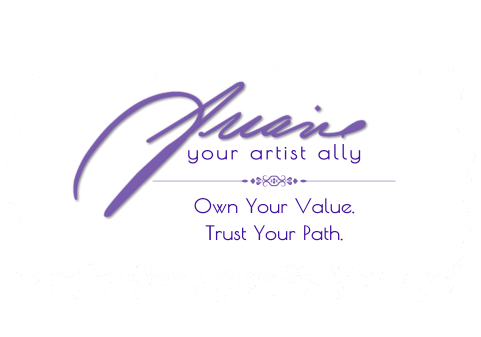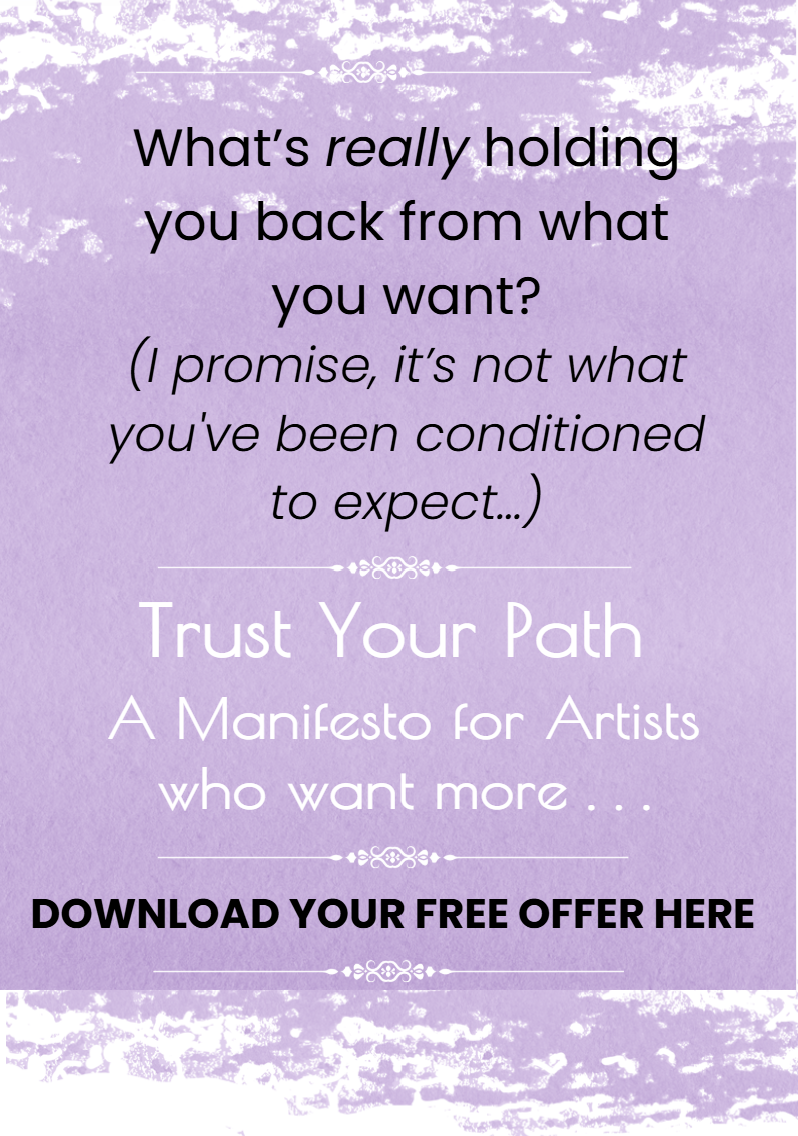Selling Your Art: The Beginning…
When a piece of your work sells, it lights you up. When I hear about it, it lights me up too.
Nothing is more validating, more affirming than someone wanting to pay you for the piece you’ve poured your heart and soul into.
It’s a high like no other.
And in that split second transfer of money for art, all the hours with their endless details—some high, some low—melt away.
But along the way, you had to take three foundational steps toward those art sales.
Each one seeming so obvious, and in some cases inevitable, that taking time to pay conscious attention might feel frivolous, or unnecessary.
I’d like to stress-test that by peeking under the ArtLife hood.

No.1 — Your art is created.
You’re putting in the time and effort to reach a certain level of skillfulness. You’re establishing your artistic fingerprint, your unique artist angle. You’re reaching deep into your creative spirit and manifesting a creative truth for the world to experience.
No.2 — Your art is visible. You’re in a gallery. Or hosting an in-studio reception. Or at an art fair. Or maintaining your website, not as a glorified portfolio, but as an experience for people who will become lovers of your work.
No.3 — You, the artist, are excited to engage. You’re answering a question from a potential collector standing next to one of your pieces in a gallery. You’re responding to an email from a potential buyer who just saw a piece on your website. You’re answering an email from someone who met someone who told that someone about your work. You’re replying to comments on Instagram that invite the sale.
Nail all three steps, in sequence, and the golden ring on the Selling Your Art Merry-go-Round is yours.
Obvious, you’re thinking.
I agree.
Only, let’s see what happens when we reverse it, shall we?
Because, after decades of experience with artists at all career levels (and in all genres), I have watched as one (or more) of these obvious basic steps become… A stumble. A missed opportunity. A missed art sale.

No.1 – Your art is sort of made. It is generic or superficial. It needs more technical expertise. Your art needs an honest critique from a trusted art-community source. It fails the authentic artistic fingerprint test. (You know…unique to only you…) Your art needs more of you more of the time.
No.2 – Your art is invisible: Your website contact form doesn’t work (and you don’t know this because you don’t email yourself—on a regular basis—from that same form!). You lost a gallery and haven’t worked yourself up to move on. Your website is a ho-hum, portfolio-only menagerie of your work. You truly think words don’t matter, so no artist statement and a boring bio.
No.3 – You, the artist, fail to engage: Because the art is invisible, how can a collector stand next to you asking questions at an opening? There is no potential collector emailing you, either from your website or from someone who never saw your work, so couldn’t recommend it to someone else. Or you have the work up on a website, but no email list and no newsletter. You do Instagram, but forget to respond to comments.
With any one of these basic building blocks, if the artist falters, selling your art falters.
Let’s Dive Deeper Into Each Basic, Selling Your Art Building Block

At first glance, Your art is created might seem too obvious to bother with until you encounter three sticky wickets : getting enough studio time, being clear about what you are making, and consistently developing your artist fingerprint.
Some might frame each of these as a problem, which, for me, is problematic. Problems have a habit of indicating that you’re at fault in some way.
If you frame these as artistic intentions, then accountability becomes connected to the impartial marker of “Is it working?” “What would work better? Faster? More easily?”
- Intention: Get enough studio time to make the work you need for selling your art.
When I gave out my Vision Questionnaire of 28 questions to the smARTist Telesummit participants, so they could identify where they were in their art career, a consistent response to one of the questions was: I need more time in the studio.
It seems everything eats into studio time: family commitments, health issues, survival issues, even the irrepressible kitchen sink makes demands.
What’s hard is to take responsibility for what part of this is unconscious self-sabotage. We might wish to lay reasonable, rational, and often guilt-laden demands at the feet of fate, or duty, or obligation, or anything but at the feet of our own choices.
It’s not to say that family commitments, health issues, survival issues, etc. aren’t real. They are, and often alarmingly so.
But first and foremost, we are responsible for how we show up. And if we are not taking stock of what we need, along with everyone else’s needs, that is on us.
Give yourself the gift you give others: the time you deserve.
It’s truly that simple.
- Intention: Be clear about what you are making so you have art to sell.
Because creativity is not genre specific, most creative people have more creative inspirations than they know what to do with.

This is both a gift and a curse. If we harness this instinct, it turns into the gift of creating with intention. But if we spend too much time chasing down one inspiration after another, it muddies our creative waters.
This doesn’t mean sticking to one thing—an impossibility for a good many of us.
It means focusing on what makes your art…well…your art. Which brings us smack into the third intention for making art: developing a consistent artist fingerprint.
- Intention: Consistently selling your art depends on a consistent Artist Fingerprint.TM
Does your work have an identifiable, artist fingerprint TM, visual cues that signal to any viewer that this work of art is yours and only yours?
Are you aware of these visual cues?
Are they intentional and conscious, or merely part of your creative flow outside of verbal language?
You know a Judy Chicago, a Georges Seurat, or a Louise Joséphine Bourgeois because they each have an artist fingerprint that immediately identifies their work and often spans decades, styles, concepts, and mediums.
Even if you’ve not thought of this before, can you look at several pieces of your work and describe what aspects are reliable from piece to piece?
It might be a technique, a way of using color, light, perspective; subject matter married to a unique technique; a crossover of artistic genres (think writing and painting).
Besides these visual cues of your art making, there’s a more enigmatic characteristic of your artist fingerprintTM: it’s the light passing through your spirit/soul into your earthly mind/body that guides you when you manifest creativity for the world to experience.
Once you put in the time and effort to hone your skill and technique, it’s time to reach deep into your creative spirit and pull out your artistic truth.

And your artistic identity is the true force behind your art sales.
So, what have we covered so far?
Let’s do a quick recap for Art Sale Building Block No.1.
When you
- get enough studio time
- and are clear about what you are making with your indelible, artistic fingerprint
- then, Your Art Is Created, becomes the obvious first Selling Your Art Building Block.

Here again, Your art is visible might seem so self-evident as to border on absurdity.
Then again…
What if your website contact form isn’t working? Or you’ve lost the one gallery (or two) that you had?
Or you keep waiting for the perfect piece to materialize under your fingers before daring to go public? Or you’ve hit a creative roadblock? Or self-doubts have asserted themselves? Or family demands force studio time off the map?
Or… your don’t sell your art because you refuse to show your work—for one reason or another.
Once upon a time, an artist contacted me for private coaching.
I had one spot left in my practice and I was excited to fill it—with the caveat that we first determine if coaching together would be a good fit. The last thing I ever want is to work with an artist who won’t, for one reason or another, be able to benefit from a coaching relationship.
This time, my standard preview session proved invaluable in a way I could have never imagined.
Ms. Private Extraordinaire (you guessed it… not her real name) had been painting for three decades. She had thousands of pieces in several storage units. But, she had never, ever, shown a single piece.
Let me repeat: Never. Shown. A. Single. Piece.
Or, put another way: Never. Sold. A. Single. Piece.
Thank goodness this was a phone conversation, and not Aoom, as I’m not known for my poker face. My voice, on the other hand, I could manage.
What’s holding you back from showing your work? My voice even, curious.
Nothing, she said. My work is private. Just for me. I don’t want to show it.
And do you have any intention of making artwork for others to experience?
No, she said, I definitely don’t want to show it.
Given that, I continued, what would you like from me?
I don’t know, she said, I was hoping you could tell me.
Is there any chance I can help you find a way to release a select group of your paintings from their storage units for an exhibition?
Or, that you would work on a select group for such an exhibition?
Meanwhile, the graphic text bubble over my head:
Any chance I can get you to release the fear cocoon
that holds you, and your creativity,
as prisoners under lock and key?
I could never do that, she replied, answering my spoken and unspoken question.
Her voice was steady. It didn’t quaver. She didn’t hesitate in her response. She held the silence that followed.
(I listen very, very carefully to silences because they always have so much to say…)
We exchanged a few pleasantries before …
I don’t see a way forward, I said, because the work I do is about artists changing the world by putting their work in the world.
She understood.
Our parting was amicable.
When the work is invisible, you literally cannot sell your art.
The trick here is understanding what “invisible” actually means.
In the case of Ms. Private Extraordinaire, invisible was literal. I’m pretty darn sure if you’re reading this, that’s not you.
Most likely, you’re working just as hard to have your work visibile as you are making the work.
Or, your work is visible, but perhaps inaccessible: An outdated website. A contact form that’s not working. A gallery with odd opening hours that keep changing. Or, heaven forbid, a gallery that doesn’t respond to queries from collectors and buyers.
I can’t begin to tell you how many times I’ve gone to an artist’s website and sent them an email from their site…and…silence. Or the last work they uploaded is 2018. There’s no artist statement (you know, that personal connection that furthers the bond between artist and collector).
So, maybe you’re not guilty of any of these “let’s-make-visibility-as-hard-as-possible” no-art-sale crimes.

In next week’s blog post, I’ll tease apart how the gap between your internal experience and your external behavior can, inadvertently, derail the visibility you need for art-sales.
It’s a process I call Map The Gap.
I’d love to “see” you here. But that’s only possible if you drop a comment or two below in the comment fields.
Tell me, do you have specific issues with making your artwork visible?









